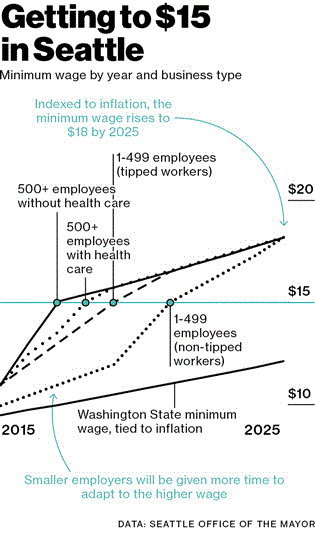Bloomberg Businessweek
http://www.businessweek.com/articles/2014-05-08/how-seattle-agreed-to-a-15-minimum-wage-without-a-fight
How Seattle Agreed to a $15 Minimum Wage Without a Fight
On May 1, Seattle Mayor Ed Murray announced he had brokered a deal to
raise the cityfs minimum wage for all workers from $9.32 to $15 an hour, the
highest in the country. That in itself was remarkable. Even more so was that
Murray did it without the anger and political bloodshed thatfs pitted employers
against workers in other cities and has stalled efforts in Congress to increase
the federal minimum wage. In what may be a model for other cities and states,
Murray put business leaders, union bosses, and community advocates in a room for
months with simple instructions: work out your differences, or else.
The gor elseh was that Murray and the city council would do it without them.
He had the political momentum to back up the threat. When Murray, a Democrat,
took office in January, the region seemed ready for a minimum pay bump. Voters
in a small town to Seattlefs south, SeaTac, passed a measure to raise wages for
transportation and hospitality workers to $15 an hour. Seattle elected a
socialist to the city council on a living wage platform. Rather than push his
own proposal through the city council, or risk outside groups bringing ballot
initiatives that would likely turn ugly and draw the attention of special
interest money, he appointed a 24-member group to reach an agreement. gIf you
want people to get here in the end, you need to bring them to the table,h he
says.

To co-chair the group, Murray chose two men on opposite sides of the debate:
Howard Wright, founder of Seattle Hospitality Group, an investor in the iconic
Space Needle, and David Rolf, president of a local SEIU Healthcare union. The
idea tested the widely held assertion put forth by business groups that
employers canft afford to pay workers more. It also offered an alternative to
the confrontational battles employees have waged elsewhere, such as the
coordinated strikes by fast-food workers in New York and dozens of other
cities.
Murray gave the group four months to work out a deal. If they failed, he
vowed to present the city council with his own proposal, which both sides were
sure to hate. He chose April 30 as a deadline because May is when outside
groups that propose ballot initiatives typically start gathering signatures.
Local business leaders decided that joining the effort was in their best
interest. gThere is no doubt in my mind that this $15 is coming to Seattle,h
says Wright. gSo if we accept that as a premise, letfs figure out how to do it
well.h Labor leaders in the group wanted a pay increase to take effect quickly;
business owners wanted to phase it in over many years. Labor insisted that tips
and benefits not count as part of someonefs wages; businesses thought they
should be able to pay lower hourly rates if they provided other compensation
such as retirement contributions. Everyone thought small businesses should get
extra time to comply, but no one agreed on how to define gsmall.h
A month before the deadline, Murray narrowed the group to eight negotiators.
The G8, as they became known, took over several rooms in the mayorfs office. A
breakthrough came on April 14, when someone—the person asked not to be
named, Rolf says—sketched out a chart showing how a proposed compromise would
let wages at different workplaces rise at different rates. Businesses could
count tips and health care in calculating minimum pay for workers, but only
temporarily. Eventually those concessions would phase out and every employer
would have to pay the same minimum wage. gYou could see the body language in the
room change,h says Rolf.
The proposal divided businesses into four groups. Large employers, with 500
workers or more, would need to pay $15 an hour by 2017. But if they provide
health insurance, like the local outdoor retailer REI, they could have an extra
year. A small business such as a dry cleaner wouldnft have to pay $15 until
2021, but a restaurant would have to ensure that workersf pay, including tips,
totaled $15 an hour by 2019. Those distinctions would phase out by 2025, when
all employers would pay the same minimum. And it would be indexed to inflation,
so theyfd never need to go through a painful negotiation again.
The final plan came together late on April 30, just before Murrayfs
ultimatum expired. The proposal now goes to the city council, where Murray hopes
to keep its nine members from taking it apart. gI imagine there will be tweaks,h
he says. With too many changes, he warns, the delicate compromise could
collapse.